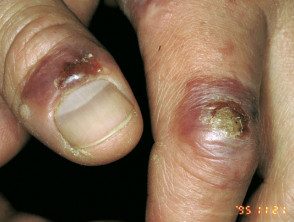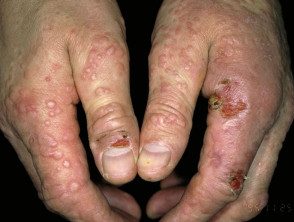What is a milker? nodule?
A milker's nodule is a infection of the skin caused by a virus that infects the teats of cows. It is sometimes called cowpock, although it is important to note that this is a different condition from cowpox (in recent reports from Europe, smallpox has been acquired from cats and small rodents rather than cows).
Milker's node is a poultry pox and it is Also called paravaccinia, pseudocowpox, and milkers node.
What causes milker's nodule?
Milker's nodule is caused by a parapoxvirus. It produces mild infections in the teats of cows, that is, ring sores, as well as ulcers in the mouth of calves. It is similar to bovine papular stomatitis virus, which affects the same sites in cattle. The two viruses are variants. Both can cause injury in the hands of dairy farmers or veterinarians examining the animals' mouths. Human infection is by contact with infected lesions in animals. It appears that no person-to-person spread has been recorded. Orf is another parapoxvirus that affects sheep and goats.
What does the milker's nodule look like?
After a incubation period of 5 to 14 days, small, raised, flat, red spots develop. Within a week they appear as firm, slightly tender, or red-blue blisters. nodules (lumps), usually between 2 and 5 in number, although they may be solitary or more numerous. The nodules are usually on the hands, particularly the fingers, but occasionally on the face. The tops of the nodules often develop grayish skin and a small Cortex. Secondary bacterial Infection can develop. Many patients develop red streaks in the lymphatic channels of the arms (lymphangitis) and some enlargement of the lymph glands.
Milker's nodules followed one week later by erythema multiforme rash

milkers nodule

milkers nodule
It is difficult to reliably distinguish milker's nodules from orf, the related condition in sheep, but the appearance of the nodules, the number of lesions, and whether the cows or sheep are primarily being contacted is a guide.
One to two weeks after the appearance of milker's nodules, some patients develop erythema multiform This is presented as a eruption small raised spots or blisters on the hands, arms, legs, and neck. This eruption fades in 1–2 weeks.
How is milker's nodule diagnosed?
In those at risk of infection due to their occupation, the diagnosis is made by the typical appearance of the lesions. A skin biopsy may be necessary The characteristic pathologic features of barnyard pox are epidermal hyperplasia, marked swelling of the dermis, intraepidermal and subepidermal blisters, and a dense mixture inflammatory infiltrate.
What is the treatment for milker's nodule?
Milker's nodules can be left to resolve spontaneously for 4-6 weeks. They must be covered to prevent contamination of the environment and also possible spread to other people. Gloves must be worn if milking. Any secondary bacterial infection must be treated.

